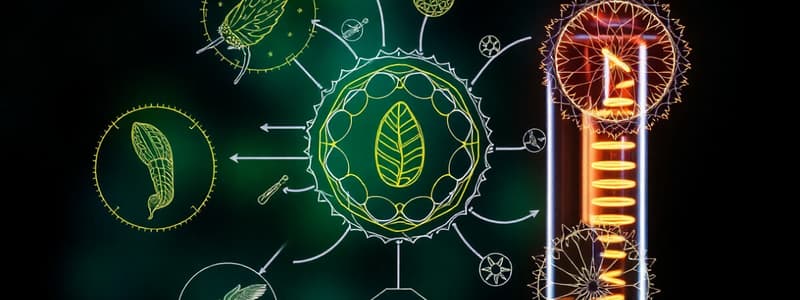Podcast
Questions and Answers
Match the following terms related to the Chemistry of Life with their definitions:
Match the following terms related to the Chemistry of Life with their definitions:
Atomic Number = The number of protons in an atom Atomic Mass = The sum of protons and neutrons in an atom Polarity = Uneven distribution of charges in a molecule Hydrogen Bonds = Attractions between different water molecules
Match the properties of water with their descriptions:
Match the properties of water with their descriptions:
Cohesion = Attraction between water molecules Adhesion = Attraction of water molecules to other surfaces Heat Capacity = Ability to absorb and retain heat Solvent = Liquid in which substances dissolve
Match the following terms with their definitions:
Match the following terms with their definitions:
Hypothesis = A scientific explanation that can be tested Inference = Logical interpretation based on existing knowledge Controlled experiment = Experiment where only one variable is changed Metabolism = Obtain and use materials and energy
Match the characteristic of life with its description:
Match the characteristic of life with its description:
Signup and view all the answers
Match the ecological terms with their meanings:
Match the ecological terms with their meanings:
Signup and view all the answers
Match the step of the scientific method with its description:
Match the step of the scientific method with its description:
Signup and view all the answers
Match the following terms related to energy flow with their function:
Match the following terms related to energy flow with their function:
Signup and view all the answers
Match the terms in Ecology with their categories:
Match the terms in Ecology with their categories:
Signup and view all the answers
Match the type of variable with its role in an experiment:
Match the type of variable with its role in an experiment:
Signup and view all the answers
Match the following concepts with their relevance to biology:
Match the following concepts with their relevance to biology:
Signup and view all the answers
Study Notes
Chapter 1: Introduction to Biology
- Science: An organized approach to understanding the natural world.
- Inference: A logical assumption based on existing knowledge.
- Hypothesis: A testable explanation for observations.
-
Scientific Method: A process for investigating the natural world:
- Observations
- Hypothesis formation (if-then statement)
- Controlled experiment design (one variable change at a time)
- Data collection and analysis
- Conclusion drawing
- Controlled experiment: An experiment where only one variable is changed, while others remain constant.
- Independent variable: The variable that is intentionally changed.
- Dependent variable: The variable that changes in response to the independent variable.
- Control group: A group that does not receive the treatment (remains unchanged).
- Biology: The study of life.
- Cells: The fundamental unit of life.
- Evolution: Change in species over time.
- Homeostasis: Maintaining a stable internal environment.
- Stimulus: A change in the environment that triggers a response.
- Metabolism: The sum of all chemical processes in an organism.
-
Eight Characteristics of Living Things:
- Composed of cells
- Based on a universal genetic code
- Obtain and use materials and energy (metabolism)
- Grow and develop
- Respond to their environment
- Change over time (evolve)
- Maintain a stable internal environment (homeostasis)
- Reproduce
Chapter 2: Chemistry of Life
- Atoms: The fundamental unit of matter.
- Atom structure: Protons (+), electrons (-), neutrons (neutral).
- Atomic number: The number of protons in an atom (determines the element).
- Atomic mass: The sum of protons and neutrons.
- Water molecule: Composed of two hydrogen atoms and one oxygen atom.
-
Water properties:
- Polarity: Uneven distribution of charge, making water a polar molecule.
- Hydrogen bonds: Weak attractions between partially positive hydrogen atoms of one water molecule and partially negative oxygen atoms of another.
- Cohesion: Attraction between water molecules.
- Adhesion: Attraction between water molecules and other substances.
- High heat capacity: Water absorbs a lot of heat before changing temperature.
- Solvent: Water's ability to dissolve many substances.
Chapter 3: The Biosphere
- Ecology: The study of interactions among organisms and between organisms and their environment.
- Species: A group of organisms that can interbreed and produce fertile offspring.
- Population: A group of the same species living in the same area.
- Community: All the populations that live in a defined area.
- Ecosystem: All the living (biotic) and nonliving (abiotic) things in an area.
- Biosphere: The part of Earth that supports life.
- Biome: A group of ecosystems that share similar climates and organisms.
- Abiotic factors: Non-living components of an ecosystem (e.g., sunlight, water).
- Biotic factors: Living components of an ecosystem (e.g., plants and animals).
- Primary consumers: Organisms that eat producers.
- Photosynthesis: The process where plants use sunlight to convert water and carbon dioxide into sugar (glucose) and oxygen.
Studying That Suits You
Use AI to generate personalized quizzes and flashcards to suit your learning preferences.
Description
Explore the fundamental concepts of biology in this introductory quiz. Understand the scientific method, hypotheses, and key biological terms that form the basis of life sciences. Test your knowledge on cells, evolution, and the principles that govern scientific inquiry.




